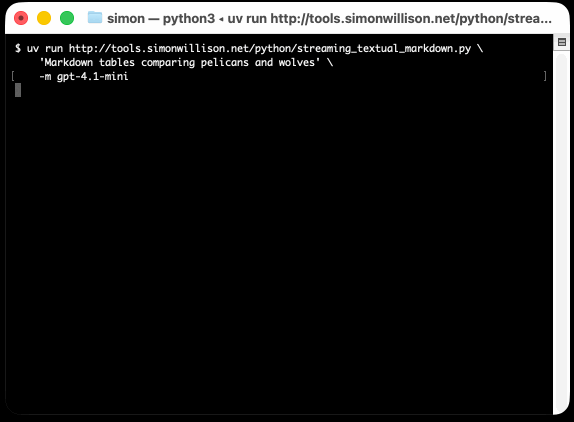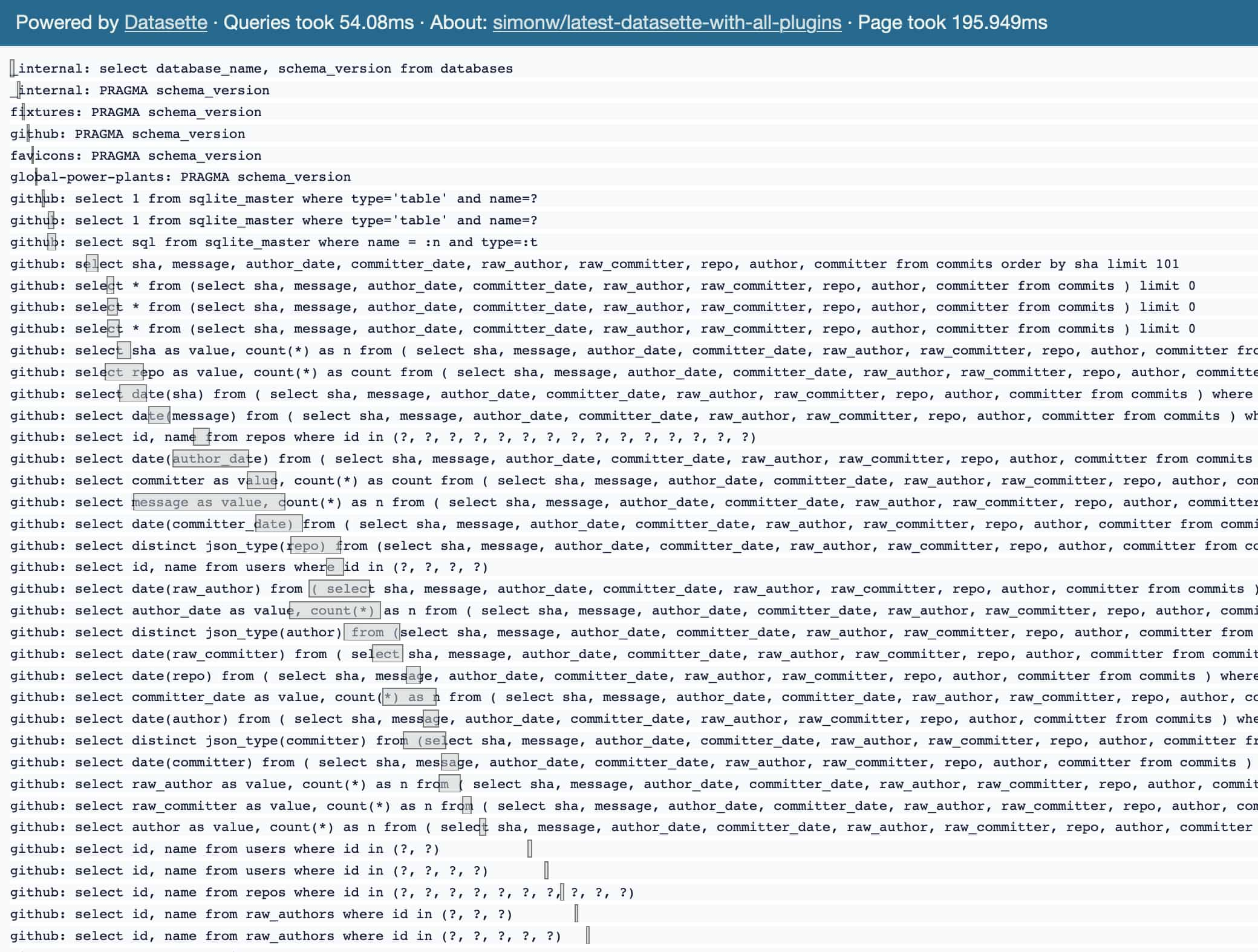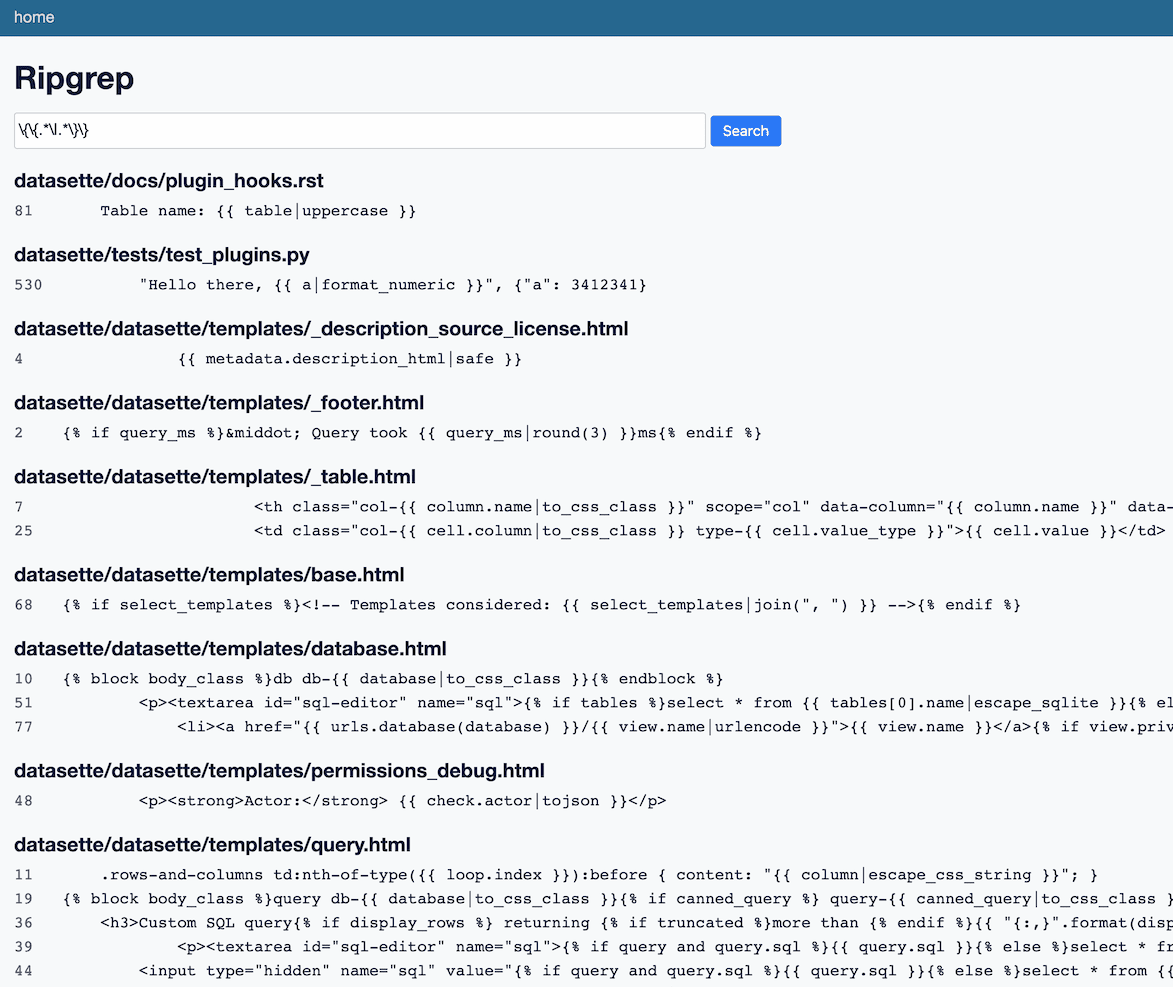47 posts tagged “async”
2025
In Python 3.14, I have implemented several changes to fix thread safety of
asyncioand enable it to scale effectively on the free-threaded build of CPython. It is now implemented using lock-free data structures and per-thread state, allowing for highly efficient task management and execution across multiple threads. In the general case of multiple event loops running in parallel, there is no lock contention and performance scales linearly with the number of threads. [...]For a deeper dive into the implementation, check out the internal docs for asyncio.
— Kumar Aditya, Scaling asyncio on Free-Threaded Python
Textual v4.0.0: The Streaming Release. Will McGugan may no longer be running a commercial company around Textual, but that hasn't stopped his progress on the open source project.
He recently released v4 of his Python framework for building TUI command-line apps, and the signature feature is streaming Markdown support - super relevant in our current age of LLMs, most of which default to outputting a stream of Markdown via their APIs.
I took an example from one of his tests, spliced in my async LLM Python library and got some help from o3 to turn it into a streaming script for talking to models, which can be run like this:
uv run http://tools.simonwillison.net/python/streaming_textual_markdown.py \
'Markdown headers and tables comparing pelicans and wolves' \
-m gpt-4.1-mini

files-to-prompt 0.5.
My files-to-prompt tool (originally built using Claude 3 Opus back in April) had been accumulating a bunch of issues and PRs - I finally got around to spending some time with it and pushed a fresh release:
- New
-n/--line-numbersflag for including line numbers in the output. Thanks, Dan Clayton. #38- Fix for utf-8 handling on Windows. Thanks, David Jarman. #36
--ignorepatterns are now matched against directory names as well as file names, unless you pass the new--ignore-files-onlyflag. Thanks, Nick Powell. #30
I use this tool myself on an almost daily basis - it's fantastic for quickly answering questions about code. Recently I've been plugging it into Gemini 2.0 with its 2 million token context length, running recipes like this one:
git clone https://github.com/bytecodealliance/componentize-py
cd componentize-py
files-to-prompt . -c | llm -m gemini-2.0-pro-exp-02-05 \
-s 'How does this work? Does it include a python compiler or AST trick of some sort?'
I ran that question against the bytecodealliance/componentize-py repo - which provides a tool for turning Python code into compiled WASM - and got this really useful answer.
Here's another example. I decided to have o3-mini review how Datasette handles concurrent SQLite connections from async Python code - so I ran this:
git clone https://github.com/simonw/datasette
cd datasette/datasette
files-to-prompt database.py utils/__init__.py -c | \
llm -m o3-mini -o reasoning_effort high \
-s 'Output in markdown a detailed analysis of how this code handles the challenge of running SQLite queries from a Python asyncio application. Explain how it works in the first section, then explore the pros and cons of this design. In a final section propose alternative mechanisms that might work better.'
Here's the result. It did an extremely good job of explaining how my code works - despite being fed just the Python and none of the other documentation. Then it made some solid recommendations for potential alternatives.
I added a couple of follow-up questions (using llm -c) which resulted in a full working prototype of an alternative threadpool mechanism, plus some benchmarks.
One final example: I decided to see if there were any undocumented features in Litestream, so I checked out the repo and ran a prompt against just the .go files in that project:
git clone https://github.com/benbjohnson/litestream
cd litestream
files-to-prompt . -e go -c | llm -m o3-mini \
-s 'Write extensive user documentation for this project in markdown'
Once again, o3-mini provided a really impressively detailed set of unofficial documentation derived purely from reading the source.
2024
In search of a faster SQLite (via) Turso developer Avinash Sajjanshetty (previously) shares notes on the April 2024 paper Serverless Runtime / Database Co-Design With Asynchronous I/O by Turso founder and CTO Pekka Enberg, Jon Crowcroft, Sasu Tarkoma and Ashwin Rao.
The theme of the paper is rearchitecting SQLite for asynchronous I/O, and Avinash describes it as "the foundational paper behind Limbo, the SQLite rewrite in Rust."
From the paper abstract:
We propose rearchitecting SQLite to provide asynchronous byte-code instructions for I/O to avoid blocking in the library and de-coupling the query and storage engines to facilitate database and serverless runtime co-design. Our preliminary evaluation shows up to a 100x reduction in tail latency, suggesting that our approach is conducive to runtime/database co-design for low latency.
googleapis/python-genai. Google released this brand new Python library for accessing their generative AI models yesterday, offering an alternative to their existing generative-ai-python library.
The API design looks very solid to me, and it includes both sync and async implementations. Here's an async streaming response:
async for response in client.aio.models.generate_content_stream(
model='gemini-2.0-flash-exp',
contents='Tell me a story in 300 words.'
):
print(response.text)
It also includes Pydantic-based output schema support and some nice syntactic sugar for defining tools using Python functions.
llm-gemini 0.4.
New release of my llm-gemini plugin, adding support for asynchronous models (see LLM 0.18), plus the new gemini-exp-1114 model (currently at the top of the Chatbot Arena) and a -o json_object 1 option to force JSON output.
I also released llm-claude-3 0.9 which adds asynchronous support for the Claude family of models.
LLM 0.18. New release of LLM. The big new feature is asynchronous model support - you can now use supported models in async Python code like this:
import llm
model = llm.get_async_model("gpt-4o")
async for chunk in model.prompt(
"Five surprising names for a pet pelican"
):
print(chunk, end="", flush=True)
Also new in this release: support for sending audio attachments to OpenAI's gpt-4o-audio-preview model.
Free Threaded Python With Asyncio.
Jamie Chang expanded my free-threaded Python experiment from a few months ago to explore the interaction between Python's asyncio and the new GIL-free build of Python 3.13.
The results look really promising. Jamie says:
Generally when it comes to Asyncio, the discussion around it is always about the performance or lack there of. Whilst peroformance is certain important, the ability to reason about concurrency is the biggest benefit. [...]
Depending on your familiarity with AsyncIO, it might actually be the simplest way to start a thread.
This code for running a Python function in a thread really is very pleasant to look at:
result = await asyncio.to_thread(some_function, *args, **kwargs)
Jamie also demonstrates asyncio.TaskGroup, which makes it easy to execute a whole bunch of threads and wait for them all to finish:
async with TaskGroup() as tg:
for _ in range(args.tasks):
tg.create_task(to_thread(cpu_bound_task, args.size))
aiolimiter. I found myself wanting an asyncio rate limiter for Python today—so I could send POSTs to an API endpoint no more than once every 10 seconds. This library worked out really well—it has a very neat design and lets you set up rate limits for things like “no more than 50 items every 10 seconds”, implemented using the leaky bucket algorithm.
2023
Writing a chat application in Django 4.2 using async StreamingHttpResponse, Server-Sent Events and PostgreSQL LISTEN/NOTIFY (via) Excellent tutorial by Víðir Valberg Guðmundsson on implementing chat with server-sent events using the newly async-capable StreamingHttpResponse from Django 4.2x.
He uses PostgreSQL’a LISTEN/NOTIFY mechanism which can be used asynchronously in psycopg3—at the cost of a separate connection per user of the chat.
The article also covers how to use the Last-Event-ID header to implement reconnections in server-sent events, transmitting any events that may have been missed during the time that the connection was dropped.
Django 4.2 released. “This version has been designated as a long-term support (LTS) release, which means that security and data loss fixes will be applied for at least the next three years.” Some neat new async features, including improvements to async streaming responses.
2022
Why Rust’s postfix await syntax is good (via) C J Silverio explains postfix await in Rust—where you can write a line like this, with the ? causing any errors to be caught and turned into an error return from your function:
let count = fetch_all_animals().await?.filter_for_hedgehogs().len();
Weeknotes: Parallel SQL queries for Datasette, plus some middleware tricks
A promising new performance optimization for Datasette, plus new datasette-gzip and datasette-total-page-time plugins.
2021
PHP 8.1 release notes (via) PHP is gaining “Fibers” for lightweight cooperative concurrency—very similar to Python asyncio. Interestingly you don’t need to use separate syntax like “await fn()” to call them—calls to non-blocking functions are visually indistinguishable from calls to blocking functions. Considering how much additional library complexity has emerged in Python world from having these two different colours of functions it’s noteworthy that PHP has chosen to go in a different direction here.
Finding and reporting an asyncio bug in Python 3.10
I found a bug in Python 3.10 today! Some notes on how I found it and my process for handling it once I figured out what was going on.
[... 1,789 words]Introducing Partytown 🎉: Run Third-Party Scripts From a Web Worker (via) This is just spectacularly clever. Partytown is a 6KB JavaScript library that helps you move gnarly poorly performing third-party scripts out of your main page and into a web worker, so they won’t destroy your page performance. The really clever bit is in how it provides sandboxed access to the page DOM: it uses a devious trick where a proxy object provides getters and setters which then make blocking API calls to a separate service worker, using the mostly-forgotten xhr.open(..., false) parameter that turns off the async default for an XMLHttpRequest call.
Async functions require an event loop to run. Flask, as a WSGI application, uses one worker to handle one request/response cycle. When a request comes in to an async view, Flask will start an event loop in a thread, run the view function there, then return the result.
Each request still ties up one worker, even for async views. The upside is that you can run async code within a view, for example to make multiple concurrent database queries, HTTP requests to an external API, etc. However, the number of requests your application can handle at one time will remain the same.
New Major Versions Released! Flask 2.0, Werkzeug 2.0, Jinja 3.0, Click 8.0, ItsDangerous 2.0, and MarkupSafe 2.0. Huge set of releases from the Pallets team. Python 3.6+ required and comprehensive type annotations. Flask now supports async views, Jinja async templates (used extensively by Datasette) “no longer requires patching”, Click has a bunch of new code around shell tab completion, ItsDangerous supports key rotation and so much more.
unasync (via) Today I started wondering out loud if one could write code that takes an asyncio Python library and transforms it into the synchronous equivalent by using some regular expressions to strip out the “await ...” keywords and suchlike. Turns out that can indeed work, and Ratan Kulshreshtha built it! unasync uses the standard library tokenize module to run some transformations against an async library and spit out the sync version automatically. I’m now considering using this for sqlite-utils.
2020
datasette-ripgrep: deploy a regular expression search engine for your source code
This week I built datasette-ripgrep—a web application for running regular expression searches against source code, built on top of the amazing ripgrep command-line tool.
[... 1,362 words]Inevitably we got round to talking about async.
As much of an unneeded complication as it is for so many day-to-day use-cases, it’s important for Python because, if and when you do need the high throughput handling of these io-bound use-cases, you don’t want to have to switch language.
The same for Django: most of what you’re doing has no need of async but you don’t want to have to change web framework just because you need a sprinkling of non-blocking IO.
The “await me maybe” pattern for Python asyncio
I’ve identified a pattern for handling potentially-asynchronous callback functions in Python which I’m calling the “await me maybe” pattern. It works by letting you return a value, a callable function that returns a value OR an awaitable function that returns that value.
[... 787 words]Waiting in asyncio. Handy cheatsheet explaining the differences between asyncio.gather(), asyncio.wait_for(), asyncio.as_completed() and asyncio.wait() by Hynek Schlawack.
Django: Added support for asynchronous views and middleware (via) An enormously consequential feature just landed in Django, and is set to ship as part of Django 3.1 in August. Asynchronous views will allow Django applications to define views using “async def myview(request)”—taking full advantage of Python’s growing asyncio ecosystem and providing enormous performance improvements for Django sites that do things like hitting APIs over HTTP. Andrew has been puzzling over this for ages and it’s really exciting to see it land in a form that should be usable in a stable Django release in just a few months.
Async Support—HTTPX (via) HTTPX is the new async-friendly HTTP library for Python spearheaded by Tom Christie. It works in both async and non-async mode with an API very similar to requests. The async support is particularly interesting—it’s a really clean API, and now that Jupyter supports top-level await you can run ’(await httpx.AsyncClient().get(url)).text’ directly in a cell and get back the response. Most excitingly the library lets you pass an ASGI app directly to the client and then perform requests against it—ideal for unit tests.
2019
... the overall conclusion I reach is that we have so much to gain from making Django async-capable that it is worth the large amount of work it will take. I also believe, crucially, that we can undertake this change in an iterative, community-driven way that does not rely solely on one or two long-time contributors burning themselves out.
2018
The ASGI specification provides an opportunity for Python to hit a productivity/performance sweet-spot for a wide range of use-cases, from writing high-volume proxy servers through to bringing large-scale web applications to market at speed.
Changelog 2018-06-12 / Observable. The ability to download an Observable notebook as a stand-alone ES module and run it anywhere using their open source runtime is fascinating, but it’s also worth reading the changelog for some of the new clever tricks they are pulling using await—“await visibility();” in a notebook cell will cause execution to pause until the cell scrolls into view for example.
Touring a Fast, Safe, and Complete(ish) Web Service in Rust. Brandur’s notes from building a high performance web service in Rust, using PostgreSQL via the Diesel ORM and the Rust actix-web framework which provides Erlang-style actors and promise-based async concurrency.
Trio Tutorial. Trio is a really nice async library for Python—a simpler alternative to asyncio, with some very clean API design. Best of all, the tutorial is fantastic—it provides a very clear explanation of async/await without diving into the intricacies of coroutines.

